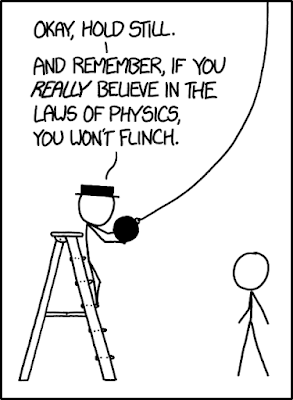The Character Of Physical Laws
Anirban Kundu
&
Partha Ghosh

|
| Photo by XKCD |
The name of this part is lifted almost verbatim from the title of the famous lecture series (a scanned copy of the whole book is available from the website of the University of Pennsylvania) by Richard Feynman, because there is no better exposition to the topic, and every student interested in science should go through this book.
The first criterion of any good physical law is its simplicity. This does not mean how simple it sounds to the layman. It is hard, almost impossible, to convey all the implications of a physical law without mathematics. Mathematics is, as Feynman says, not only the language of science but also the supporting logic. By simplicity, we mean that the law should not invoke more initial assumptions or free parameters than what is strictly necessary. This principle was first initiated in the fourteenth century by the English philosopher William of Ockham and is known as Occam’s (alternative spelling of Ockham) razor. The masses of atomic nuclei are something that one can never calculate from first principles. The scientists use a formula, which involves only five arbitrary parameters. All these parameters have some physical justification, and one can calculate the mass of any nuclei—there are hundreds of them—to a good precision using this formula. This is a nice example of Occam’s razor. We could have used 10 parameters, and that would have probably given us a slightly better fit, but the gain is not worth the introduction of five more parameters.
The second criterion is the range of applicability of the law. A good physical law should be predictive, i.e., it should not only explain some existing data but also predict something not yet observed. Again, think of Newtonian gravity. Just by applying the laws of gravity, Urbain Le Verrier and independently John Couch Adams predicted the existence of a planet behind Uranus, whose attraction was responsible for some minute deviations from Uranus’ orbit. Almost at the position predicted, astronomers found Neptune. Another example is the determination of the velocity of light by the Danish astronomer Ole Rømer; he assumed the laws of gravity to hold, and with that found the velocity of light by observing the eclipses of the Jovian moons.
The third criterion is the universality of the laws. Everyone, even the ancient cave dwellers, could have said that an apple falls on earth because the earth pulls the apple towards it. Just saying this is not the discovery of gravity. Newton’s contribution was to find the universal law: the same law works for the apple and the earth, for the solar system, and for distant galaxies. It is the universality for which we credit Newton.
A Short Example:
Our quest about the nature of light is a perfect example of how science should proceed. Newton’s ‘Opticks’, published in 1704, is a supreme example of inductive logic. He described experiment after experiment to understand the properties of light. By experimenting with white light and a prism, he overthrew the dogma that white light, the light coming from the sun, is pure. Newton believed that light consists of “light particles”, which is consistent with the observed properties like rectilinear propagation.
Then came Thomas Young who showed that several properties of light can only be explained if light is thought of as a wave, and the corpuscular theory of Newton fell out of favor. Waves, like sound or water waves, need a medium to propagate, so how does the light from the Sun reach us? To solve this --- an application of Occam’s razor --- scientists assumed an all-pervading medium through which light propagates, which was named ‘Luminiferous Aether’ (Luminiferous means ‘light-bearing’; nothing to do with what the chemists call ether). James Clerk Maxwell showed that the motion of electric charges and magnets can produce waves. They are called electromagnetic waves. The velocity of such waves can be calculated using quantities measured in the laboratory. It turns out to be the same as the velocity of light! This led Maxwell to surmise that light is an electromagnetic wave. In the late nineteenth century, Michelson and Morley showed very clearly that ether does not exist. This was a shock for the wave theorists, but was quickly resolved: the light waves have a crucial difference with sound waves, and the undulation is in such a way that it does not need any medium to propagate.
Another example of Occam’s razor was that; the photoelectric effect came as a stronger shock. When light falls on a metal, electrons may come out. The experiments showed very clearly that it cannot be described by the wave theory; rather, the out-of-favor corpuscular theory could have done a better job. Einstein gave an explanation in 1905 (for which he received the Nobel Prize), and that conclusively proved that light is indeed a stream of tiny energy packets. That such packets should exist was predicted five years ago by Max Planck but the photoelectric effect provided the final evidence. We now call these packets photons.
So, what is light? Both Young’s experiments and Maxwell’s theory are irrefutable, but so is the photoelectric effect. Now we think that light has both wave and particle nature, like a two-faced beast, and depending on the experiment you perform, it shows one of the faces. Never both.









No comments
মন খুলে মন্তব্য করুন। আমাদের সময়-সুযোগ মতো মডারেশন হয়, তাই মন্তব্য এই পাতায় ফুটে উঠতে কিছু সময় লাগতে পারে। নইলে নিশ্চিন্ত থাকুন, খুব খারাপ কিছু বা স্প্যাম না করলে, মন্তব্য ঠিক বেরোবে এই পাতায়।